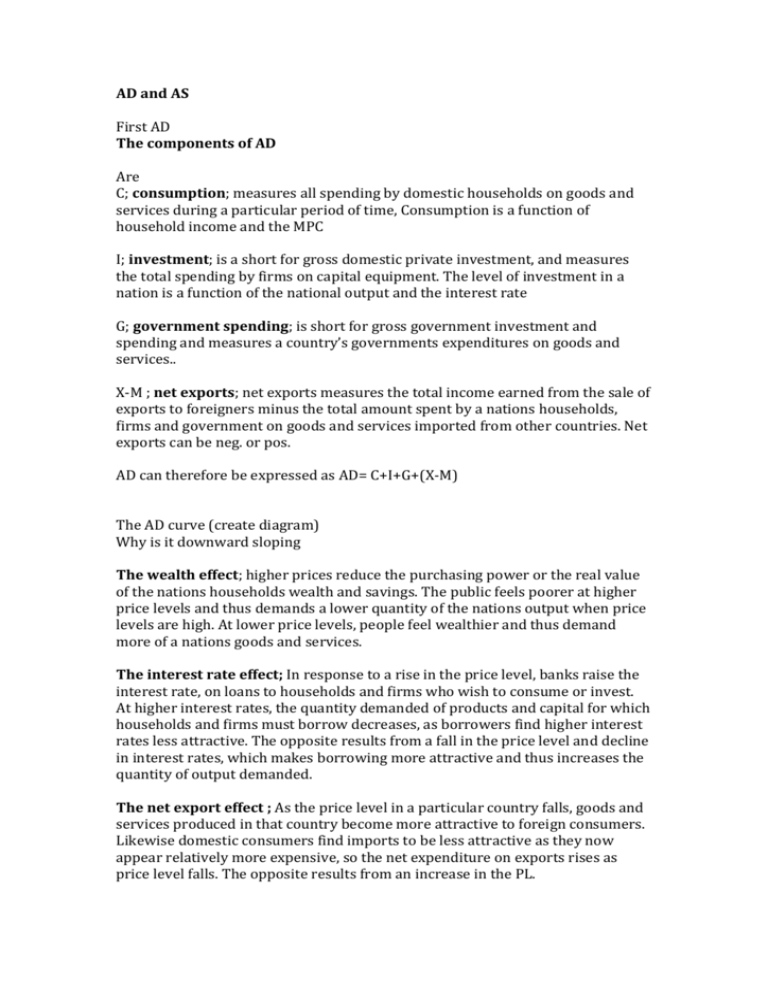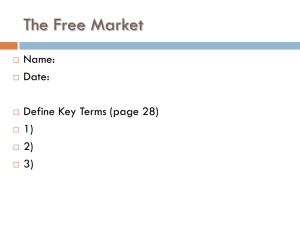AD and AS
advertisement

AD and AS First AD The components of AD Are C; consumption; measures all spending by domestic households on goods and services during a particular period of time, Consumption is a function of household income and the MPC I; investment; is a short for gross domestic private investment, and measures the total spending by firms on capital equipment. The level of investment in a nation is a function of the national output and the interest rate G; government spending; is short for gross government investment and spending and measures a country’s governments expenditures on goods and services.. X-M ; net exports; net exports measures the total income earned from the sale of exports to foreigners minus the total amount spent by a nations households, firms and government on goods and services imported from other countries. Net exports can be neg. or pos. AD can therefore be expressed as AD= C+I+G+(X-M) The AD curve (create diagram) Why is it downward sloping The wealth effect; higher prices reduce the purchasing power or the real value of the nations households wealth and savings. The public feels poorer at higher price levels and thus demands a lower quantity of the nations output when price levels are high. At lower price levels, people feel wealthier and thus demand more of a nations goods and services. The interest rate effect; In response to a rise in the price level, banks raise the interest rate, on loans to households and firms who wish to consume or invest. At higher interest rates, the quantity demanded of products and capital for which households and firms must borrow decreases, as borrowers find higher interest rates less attractive. The opposite results from a fall in the price level and decline in interest rates, which makes borrowing more attractive and thus increases the quantity of output demanded. The net export effect ; As the price level in a particular country falls, goods and services produced in that country become more attractive to foreign consumers. Likewise domestic consumers find imports to be less attractive as they now appear relatively more expensive, so the net expenditure on exports rises as price level falls. The opposite results from an increase in the PL. What are the determinants of AD or shifts in the AD curve Determinants of consumption C Usually makes up the largest component of AD The level of the national income is the primary determinant of consumption in a nation. A nations income does not equal its consumption but consumption is a function of national income. In addition to consuming goods and services, a nations households will also pay taxes, save or buy imports with the income earned in a year. Consumption; the % of national income that goes towards consumption is determined by the nations average propensity to consume or APC. APC is found by dividing the level of consumption C by the level of national income Y. C APC = ----Y Savings; at lower levels of income, households tend to consume with a greater proportion of their income than at higher income levels. This means that the amount of income saved is less at lower levels than at higher. The average propensity to save APS is S divided by the national income Y this tells us the % of a nations income that is saved APS = Taxes; All governments collect taxes. The % of the nations income collected in taxes tells us the average rate of taxation ART. The ART is found by dividing the total taxes collected in a country T by the nations income Y. ART = Imports; households may consume goods or services produced abroad, which counts as imports to a nation and is thus not included as part of the national aggregate demand and is subtracted from GDP. The average propensity to import APM is the % of national income spent on imports M APM = All of a nations income goes towards consumption, savings, paying taxes or buying imports, therefore APC + APS + ART + APM = 1 Consumption increases at a decreasing rate with income. The higher the nations income of households the lower the average propensity to consume. Non Income Determinants of Consumption Wealth; wealth is the total value of the accumulated assets owned by an individual, household, community or country, minus all its liabilities. The wealthier a nations households, the greater the level of consumption. Wealth differs from income, because it does not measure the money flowing to households from their provision of land, labor and capital in the resource market, it measures the value of assets accumulated over time. It is important to note that wealth is not a real or tangible object, it is an abstract concept and hence not likely to change economic behavior. (what I mean by this is if I were to tell you that you were wealthy, would it change your consumption habits?) Although with that said, consumption does have a direct relationship over such things housing, stocks and bonds are affected. Real Interest rates; The interest rate is the opportunity cost of spending money, if firms or households borrow money to finance spending on capital or land, the interest rate is the price they must pay above and beyond the amount borrowed to the bank. Therefore, there is an inverse relationship between the interest rate in a nation and the quantity of funds demanded for investment and consumption. So as you can see if a state raises it rate of interest is slows its economy down, as less loans are taking out and more money is placed into savings and on the other side if the state lowers its interest rates more money is taken out speeding up the economy. Don’t forget about inflationary pressure, be aware that banks changes a nominal interest rate and then account for inflation. Household debt and expectations of future income The level of household debt can shift the consumption curve left or right Household debt is the amount of money owed by a household to lenders, including consumer debt accrued through the use of CC or by borrowing from a bank to finance the consumption of durable goods. In the short run, an increase in consumer debt allows households to increase consumption at each level of household income. In the long run the debts need to be paid back. Which reduces the consumption of the household in the future. Consumer Confidence JMK called it the animal spirit, or the confidence of the households and firms in the economy. High confidence more consumption, lack of confidence lack of consumption. Determinants of investment I Investment is the second component of a nations AD, investment is defined as spending by firms on capital equipment or technology and by households on newly built homes. Interest rates; At a higher interest rate Firms have an incentive to save earning form the sale of their output, as the returns on saving are higher. Firms, will be less likely to invest in capital when returns are greater on investments in interest earning assets such as savings accounts and government bonds. Higher interest rates mean greater returns on household’s savings, so household’s prefer to keep money in banks or other interest bearing assets rather than investing in capital or new homes. At higher interest rates, the cost of borrowing to finance capital investments is greater. Since interest payments add to a firm’s costs, higher interest rates mean higher costs and smaller profits. There are fewer investments in capital with an expected rate of return equal to or greater than the rate of interest. Lower interest rates The opportunity costs of buying new capital falls and firms are more likely to invest revenues earned from their sales in new capital equipment in order to expand their output or simply to replace deteriorating capital stocks. The returns on interest bearing assets such as saving accounts and govt. bonds falls when interest rates are low, so there is less incentive to save earnings. Households are less willing to save and more willing to borrow to invest in new homes when interest rates are low. The cost of borrowing money to finance investments in new capital or tech is lower More capital investments have an expected rate of return equal to or greater than a lower interest rate than when interest rates are high. Diagram inverse relationship between real interest rates in the economy and the demand for funds from private investment and a direct relationship between real interest rates and the supply of loanable funds. Also known as the loanable funds market diagram In addition to real interest rates, investment in the private sector also depends on the expectations of firms. Business Confidence Investor confidence is directly influence by consumer confidence. Future prices; if prices are falling you are likely to see a slow down of investment until firms see prices go up again. Technology; new tech often leads to periods of increased investment by firms adopting the tech or providing goods and services to consumers that incorporate the new tech. Business taxation or taxation in general; an increase in tax will always slow down investment and the opposite is true with a decrease in taxation Inventories; when businesses are unable to sell all of the output they produce in a given period of time, their inventories grow and this reduces the need to invest in new capital. The degree of excess capacity; If firms can easily increase output because they are producing below their full capacity, they are less likely to invest in new capital, however if a nations firms are using existing capital resources at or near their full capacity, they need for investment is much stronger. Thurs Feb 28th Determinants of Govt. spending G Government spending includes a broad range of expenditure from public schools to national defense, highways, parks and hospitals. Governments may spend directly on the provision of goods or may subsidize the private sector. This is made up of government fiscal and monetary policy. Determinant of net exports X-M Spending by domestic households and domestic firms as well as spending by foreign households and firms. That will raise or lower the net exports of a state. Incomes abroad If a nations who imports from your state has improved incomes then you should see increase consumption of your goods and an increase in your exports, the opposite is true if a trading nation has a decrease in is average income levels. Tastes and preferences of consumers Certain nations are known to produce certain goods and we want those good from that state, thus increasing that states exports. Whether its true or good advertising it still works. Exchange rates An exchange rate is simply the price of a currency expressed in units of another currency. While a strong currency may sound desirable Protectionism The degree to which a nation and its trading partners practice protectionism affect what % of its GDP is made up of exports. Create Collage, AD With A4 paper, create a collage showing the components of AD and writing how that particular component can create a shift or change in AD. Hand out AD shift worksheet/ group due at end or next class Intro to AS Time permitting introduction to AS Mon March 5th Continue work on AS Look at Keynes vs Hayek video (need to download) Aggregate Supply Causes of an increase in AS A change in the price level in a country resulting from a shift in AD causes a movement along the nations AS curve. In the short run, a fall in AD causes a fall in output and a small decrease in the price level. In the long run, when wages have adjusted to the lower AD, the SRAS curve shifts to the right and output is restored at the full employment level and at a lower price level. ( Which we will work on next class) The SRAS curve shifts to the right only after the wage rate in the economy falls because of low demand for output and labor. Besides a change in the wage rate, other factors that can lead to an increase in the SRAS include. Lower resource cost ( oil, minerals and other raw materials) Improvement in the productivity of land or capital Reduction in the minimum wage Government subsidies to producers Investment tax credits (encouraging firms to invest in capital) Reduction in trade union power Better infrastructure Better educated or more skilled workforce (increase the productivity of labor) Stronger currency (makes imported resources cheaper) Causes of a decrease in SRAS Increase in resource costs ( oil, energy shortages, higher food prices) Increases in trade union power Increases in the minimum wage Higher business taxes Weaker currency (makes imported raw materials more expensive)








